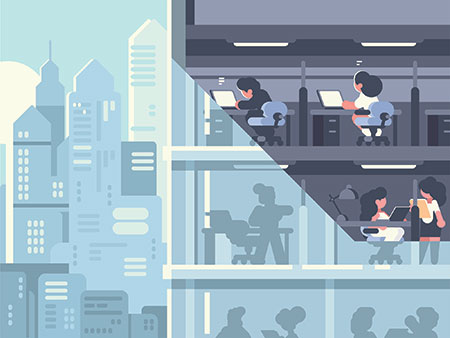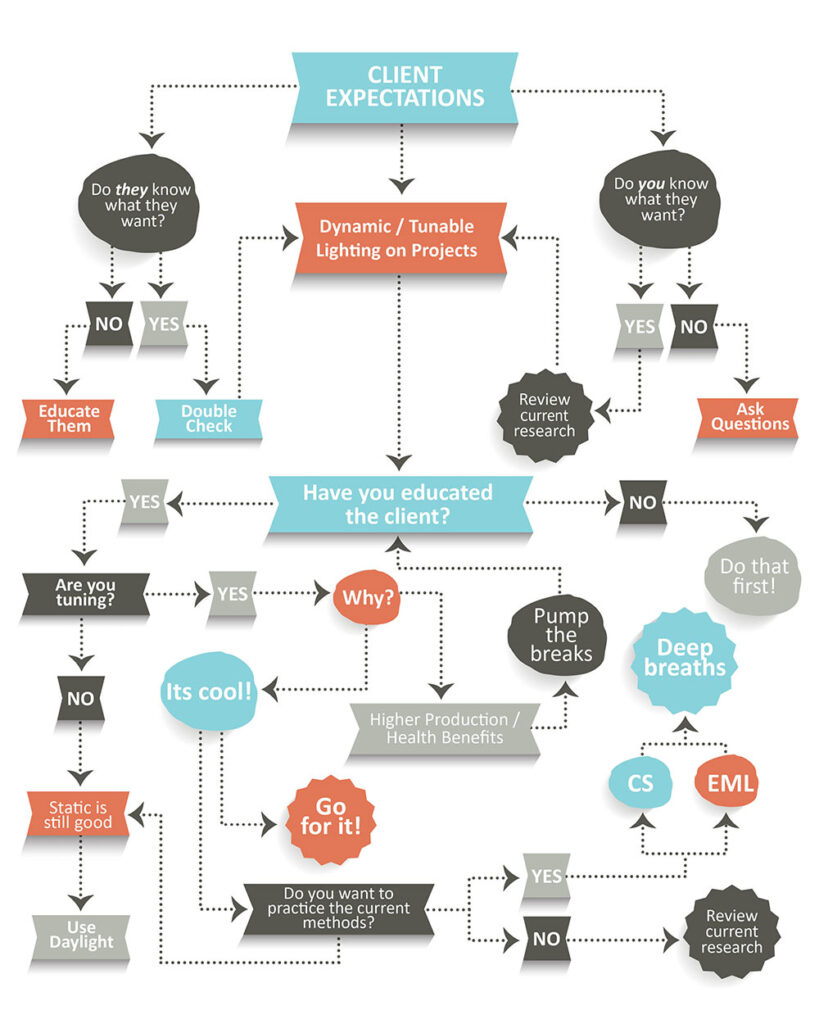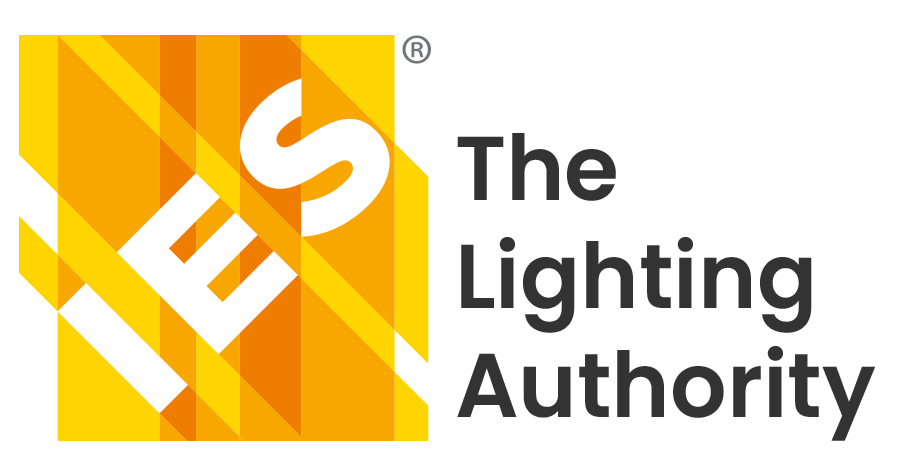When the job description suddenly includes ‘amateur biologist,’ lighting designers must be able to decipher the circadian lexicon for their clients
By Rachel Fitzgerald and Katherine Stekr
 Buzzwords like “human-centric lighting” and “circadian-supportive lighting” are everywhere right now in our industry. But as lighting designers, what do we really need to know when designing lighting solutions for the workplace in this era of circadian buzz?
Buzzwords like “human-centric lighting” and “circadian-supportive lighting” are everywhere right now in our industry. But as lighting designers, what do we really need to know when designing lighting solutions for the workplace in this era of circadian buzz?
The body of available research is growing daily and with it come changes to potential approaches. How do we create design solutions today, knowing whatever we come up with could potentially be rendered obsolete based on new information in the not-too-distant future?
Lighting designers have had to add “pseudo-biologist” to their repertoire of skills when understanding new research over the past few years. Sure, the profession always required the designer to call upon their inner peacekeeper, artist, psychologist and engineer, but now we’ve added another layer of complexity. What follows are six key factors for designers to ponder as they evaluate circadian techniques in workplace applications.
How Light Affects Our Bodies. In the simplest of terms, since most of us are not trained biologists, doctors or researchers, light enters the eye and activates photosensors on the back of the retina (the oldies but goodies: rods and cones, and the new guys: ipRGCs). Through processes which are still being researched and understood, the ipRGCs activate your suprachiasmatic nucleus. This is the area of the brain responsible for our 24-hour sleep-wake cycle that starts a biological process in motion to either suppress or increase melatonin production, depending on the duration of exposure to various wavelengths and intensities of light that enter the eye.
There are currently a few competing ideas for quantifying effects of light on the human biologic system: The Lighting Research Center’s (LRC) Circadian Stimulus (CS) and Equivalent Melanopic Lux (EML) as described in a 2013 paper by Lucas et al, which is referenced in the first version, V1, of the WELL Building Standard. CS is a model that looks at the aggregate human system and how melatonin suppression responds to light. EML measures how one chemical in your retina responds to light. They are not interchangeable, but we as an industry should understand them both until the CIE, IES or another governing body determines a metric which adequately represents this complex biological relationship. There’s still much to learn about this intricate system and more information is coming out all the time. Complicating matters further, there are currently no standards to which designers can look for guidance.
Why it Matters to Our Health. At this point, any good designer may ask, “Why does this matter?” And that would be a fair question. We know the biological process of synthesizing light affects our bodies. The production and suppression of melatonin is fundamental in regulating our sleep-wake cycle. In fact, it is an important component in the regulation of a lot of systems in our bodies. There is a growing body of research which shows that maintaining a proper sleep-wake cycle can help our bodies fight cancer, wash our brains of plaques that can cause dementia and Alzheimer’s, reduce depression and much more.
Health issues related to our sleep-wake cycles can be directly correlated to the built environment. Presently, our society doesn’t have the best work-life balance and many people are working in areas that have less than ideal lighting conditions that do not support our natural sleep-wake cycles. This should matter to our workplace clients. Given what is known today about the potential impacts lighting can have on employees, we are finding educated clients are more inclined to create spaces that are healthy and feature the newest technologies for improved employee retention and productivity. Enter, the circadian buzzword.
Applying What We Know. What does circadian lighting look like in practice? Based on what we know today, how do we design a lighting system to support healthy sleep-wake cycles while we wait for more concrete metrics and guidelines? We are in an era of developing prudent solutions to fit our client’s needs while educating them on new information as it becomes available. In our practice, that all comes down to defining the criteria for success on each project with our clients.
For example, design goals may be very different for a 24/7 call center without access to natural light than for a traditional 9-to-5 corporate client moving into a LEED-Certified base building that has great daylight penetration and perimeter open-office layouts. The solutions for these clients will vary depending on how they work and what their employees need.

How Different Design Solutions Might Impact Sleep-Wake Cycles. Designing a lighting system that might affect our sleep-wake cycle, as suggested by current available research, can be achieved in two ways: (1) using a static white system which varies the intensity of lighting throughout the work day and (2) using a dynamic lighting system that can vary spectrum and intensity throughout the work day.
Just because we can potentially affect occupants’ sleep-wake cycles with these systems, should we? That’s not to say that these systems should not be used. It’s to suggest that clarity is needed when we are explaining to our clients what these proposed systems are going to do. We are finding there is an intangible component of the perceived color shift throughout the day that simply adds to the value of the space. It’s an ethereal benefit that is hard to quantify, but undoubtedly makes spaces more interesting and appealing to occupants. We know great daylighting design, likely the best form of circadian lighting, promotes heathier workplaces. Perhaps more research will answer this question for us in the future, but it’s food for thought when designing today.
Whether opting to design with static or dynamic solutions, the luminaire options for implementation are endless. There are countless solutions for static white LED lighting with desirable spectral distributions that work with the current research. Think: recessed volumetric troffers, suspended direct/indirect luminaires, indirect suspension or cove lighting. The list is endless. If we think about how cavemen lived, with high overhead sunlight during the day and low firelight at night as a historically natural circadiansupportive lighting concept, it might be worth considering more indirect solutions for the workplace and lower level lighting for residential or non-daytime work environments.
Dynamic solutions may add value, but at a cost. The luminaires tend to come at a higher price and the control infrastructure gets more complicated when implementing these newer dynamic systems. We are going from using easily understood 0-10-V protocols to having to design systems that function more like theatrical solutions. We’re learning through trial and error that chip compatibility when mixing different luminaire types from different manufacturers to achieve a unified, tunable solution can be tricky. For example, 3500K from a two-chip dynamic luminaire is not always visually the same as 3500K from a fivechip dynamic luminaire. And designers are often limited when it comes to decorative, with only static options available to intermix into a tunable design scheme.
Managing Expectations and Risk. There is a lot to process when thinking about whether we should design a lighting system to be “‘circadian”’ supporting. One of the main issues to be aware of goes back to the established criteria for success. If the client understands what these systems will and won’t do, then the result is usually a success. Managing risk for this new idea is not unlike how we manage risk in other parts of the design process with clients. Clear understanding up-front on what the system is meant to do, and not over-promising, is essential. Systems that mimic natural daylighting are great in the right applications.
Research shows in hospitals and elderly facilities, since occupants’ 24-hour cycle is totally controlled, there are benefits from using these circadian-supporting systems. In offices and other typical eight-hour occupied spaces, employers don’t have control over occupants’ screen time, daylight exposure after hours, sleep schedules, etc., so there is added risk in promising to design lighting systems that will make occupants feel better, work harder or be healthier.
Bottom Line: Stay Informed, Curious and Generous with What You Know. Perhaps our role in this current space, when designing for the eight-hour workplace, is to slow down, educate ourselves and our clients, and keep asking questions. As responsible consumers and self-proclaimed expert advisers to our clients, we need to make sure we’re up-to-date on the research, we need to continue questioning our manufacturing counterparts about what their products can do, and we need to educate our clients on how much there is still left to learn.
We also need to share our experiences, even with our competitors. Up until the revolution of the lighting industry with the mainstream acceptance of LEDs in the marketplace, the lighting community had a certain tribal knowledge passed from the most senior designers to the younger staff they were mentoring. Around 2010, this knowledge was mostly useless due to the rapid changes in technology. Now, we as a community need to rebuild our tribal knowledge and share our failures and successes with our fellow lighting designers.
We also need to push our research counterparts for metrics and guidelines and ask for clear information about what is still left to be figured out. We need to question manufacturers on misinformation. Tunable, dynamic white lighting might be the wave of the future, and it very well may do all it has been hyped up to do, but we don’t know that yet. We, as lighting designers, need to work as a collective group—supporting and sharing what we learn—just like we’ve done in the past, to promote a better and potentially healthier future.


